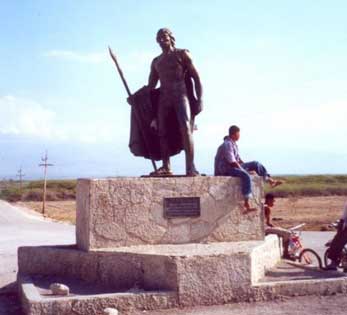Enriquillo cooperated with the Spaniards, ordering his people to mine gold and grow food for them, until 1519 when Andres seized not only enriquillo's prized mare but also his wife, Mencia, to whom he had been married to in a sanctified Catholic ceremony. Enriquillo went to the town's leading Spaniard, Pedro de Vadillo, to demand justice, but Vadillo reprimanded him for speaking out against Andres. Furious, Enriwuillo consulted the church fathers in the capital, and they approached the royal Audencia (government council) with Enriquillo's demands for justice. Although the Spanish officials in the capital sympathized with the cacique and order Mencia's release, Enriquillo was forced to take their letter back to Vadillo, who threatened to jail him or put him in the stocks if her pursued the issue. Enriquillo gathered up Mencia and the rest of his people and led them to the desolate lands called Bahoruco, and from there he staged successful raids against the Spaniards for the next 13 years. As his fame spread, rebellios Indians and African slaves joined him.

The statue of Enriquillo
Over the years, numerous heavily armed bands of Spaniards were sent to dislodge Enriquillo, but they had no success until the 1533 expedition of Captain Francisco de Barrioneuvo, who bore promises of a pardon and liberty from King Charles V—and who took along the Dominican friar Bartolome de Las Casas to convince the Cacique of the inscereity of the offer. (Las Casas described Enriquillo as "grave and strict," neither handsome nor ugly, tall, with a well-proportioned body.) Enriquillo reconciled with the king and agreed, henceforth, to return runaway slaves to Spanish officials. Later, a group of escaped slaves attacked the town of Azua, where Enriquillo was buried in 1535, to retaliate for his actions against black slaves.
Bohoruco remained a refuge for rebellious cimarones ("runaway slaves") until the late-nineteenth century. Today, there is a monumental sculpture dedicated to Enriquillo on the main road to Bahoruco, and the large salt lake in the region is known as Lago Enriquillo. The region is still considered unruly, for it is a center of voodoo.